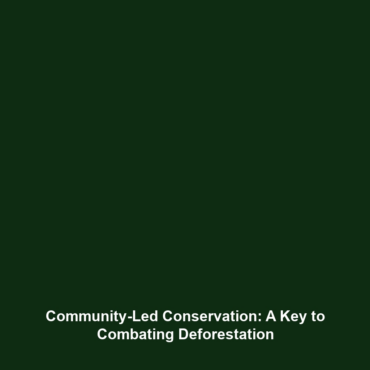Community-Led Conservation: Empowering Local Efforts
Introduction
Community-led conservation plays a vital role in addressing the dual challenges of deforestation and biodiversity loss. By empowering local communities to take charge of their natural resources, this approach not only fosters sustainable practices but also enhances conservation outcomes. In the face of increasing environmental threats, understanding the significance of these community-driven initiatives is essential for tackling the pressing issues of forest degradation and the decline of wildlife populations. As the urgency of preserving our planet’s biodiversity escalates, community-led conservation emerges as a beacon of hope, integrating local knowledge and active participation in the fight against resource depletion.
Key Concepts
At the core of community-led conservation are several fundamental principles that pivot around local knowledge, cooperation, and sustainable resource management:
Empowerment and Participation
Community-led conservation emphasizes the importance of empowering local populations by involving them in decision-making processes regarding conservation efforts.
Integration of Traditional Knowledge
Utilizing traditional ecological knowledge helps align conservation strategies with local cultural practices, making initiatives more effective.
Collaboration with Stakeholders
Building partnerships with governments, NGOs, and academic institutions enhances community capacity and resource access.
Applications and Real-World Uses
Community-led conservation has yielded significant results in various ecosystems, illustrating the effectiveness of local engagement. Here are some notable applications:
Case Study: The Amazon Rainforest
In the Amazon, indigenous communities have implemented sustainable land use practices that have helped to curb deforestation while preserving biodiversity.
Marine Conservation Efforts
In coastal regions, local fishers have organized to establish marine protected areas to prevent overfishing and protect aquatic biodiversity.
Restoration Projects in Africa
In several African nations, community-led tree-planting initiatives have successfully rehabilitated deforested areas, significantly improving regional biodiversity.
Current Challenges
Despite the successes, several challenges hinder the proliferation of community-led conservation initiatives:
- Funding Limitations: Many community efforts struggle due to inadequate financial support.
- Political Barriers: Conflicting government policies can undermine community initiatives.
- Cultural Conflicts: Misalignment between community desires and external conservation agendas can hinder progress.
Future Research and Innovations
Innovative technologies and research are shaping the future of community-led conservation:
Use of Technology
Satellite monitoring and drone technology allow communities to track deforestation and support transparent resource management.
Community-Based Biodiversity Monitoring
Developing mobile applications empowers local residents to report biodiversity changes, fostering greater community engagement.
Conclusion
Community-led conservation is a crucial element in addressing deforestation and biodiversity loss. By empowering local populations to actively participate in conservation efforts, we can create a sustainable future for our planet’s ecosystems. As we move forward, further investment and support for these initiatives will be pivotal. Embracing the wisdom and capabilities of local communities can redefine conservation strategies for lasting environmental impact. For more information on sustainable practices, explore our related topics on sustainable development and community engagement.
